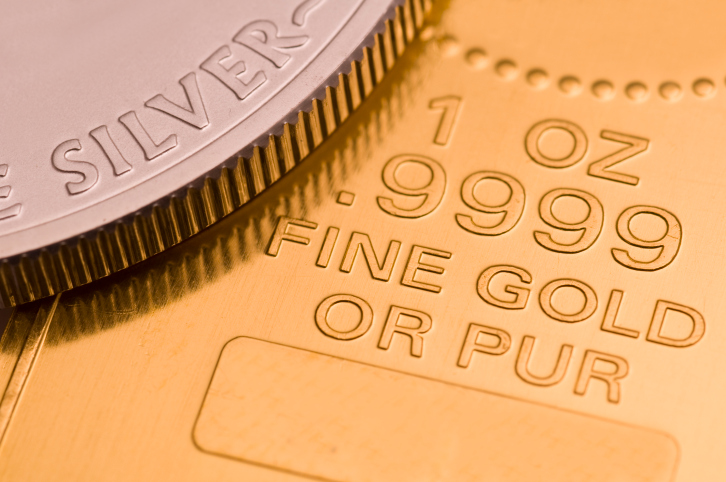Commodities & Metals
Gold and Silver: Look for Another Great Year in 2013
Published:
Last Updated:

Silver, which closed out 2012 at about $30 an ounce (up 8.3% over 2011) could rise by nearly 40% in 2013 according to some estimates, and one estimate has the price rising to $54 an ounce by the end of the year. Bloomberg records a median estimate of $40.25 an ounce for 2013.
The other precious metals — platinum group metals (PGMs) platinum and palladium, among others — are also expected to rise, from current palladium levels of around $680 an ounce to $736, according to Barclays, and $750, according to HSBC. Current platinum prices of around $1,550 an ounce are expected to rise to $1,710 next year, according to HSBC.
Here at 24/7 Wall St., we looked at some of the drivers behind these price estimates and what 2013 might hold for stocks related to precious metals.
The demand for gold is down to two big drivers going into 2013: emerging market central banks and exchange-traded products backed by physical gold. Central banks, especially from emerging market nations, have been acquiring gold as a means of diversifying their reserve holdings. The yellow metal functions as an insurance policy against the day they will be forced to fire up the printing presses (this could be said of virtually all central banks). Demand from central banks is expected to top 500 tons in 2013, up from an estimated 465 tons this year.
Retail investors in gold either view the yellow metal as a hedge against inflation, a safe haven if the whole world goes crazy or as just another asset class in which to invest. These investors can choose between ETFs backed by physical gold or gold-mining stocks that are substantially exposed to gold prices.
Funds backed by physical piles of gold run a close second to central banks when it comes to gold demand. The SPDR Gold Shares Trust (NYSEMKT: GLD) and the iShares Gold Trust (NYSEMKT: IAU) both offer shares backed by physical gold and both have demonstrated lackluster performance this year, up about 6%. Gold and silver dropped in yesterday’s trading after the Fed’s FOMC meeting minutes showed that the Fed’s bond buying could end by the end of 2013.
All gold ETFs worldwide currently hold a record total of 2,630 tons of the yellow metal. The iShares Silver Trust (NYSEMKT: SLV), backed by physical silver, held nearly 19,000 tons at the end of November.
The precious metals sector that looks to be in for the worst time in the new year is mining. Rising costs, labor unrest and deteriorating ore concentrations made profits hard to come by in 2012 and may get worse this year. Gold miners Barrick Gold Corp. (NYSE: ABX), Goldcorp Inc. (NYSE: GG), Kinross Gold Corp. (NYSE: KGC) and Newmont Mining Co. (NYSE: NEM) are down about 24%, 20%, 17% and 24%, respectively, since the beginning of 2012. Only Yamana Gold Inc. (NYSE: AUY) is showing a gain, up nearly 13%. Costs will continue their inexorable rise as ore quality declines causing production to slow. Labor troubles only contribute more to the unsavory equation.
Silver miners Coeur d’Alene Mines Corp. (NYSE: CDE) and Silver Wheaton Inc. (NYSE: SLW) were down about 1% and up 23%, respectively, in 2012. Silver is far more widely used as an industrial metal than is gold, but if the global economy slows down next year, industrial demand for the devil’s metal likely will fall. Investors are expected to purchase 300 tons of silver in 2013, but the physical surplus is not expected to be soaked up by industrial users, even if the economy is robust. That means silver prices could experience only a very modest gain in 2013.
The mining ETFs have also been pummeled this year. The Market Vectors Gold Miners ETF (NYSEMKT: GDX) fell about 12% in 2012 and the Market Vectors Junior Gold Miners ETF (NYSEMKT: GDXJ) dropped more than 19%.
The Global X Silver Miners ETF (NYSEMKT: SIL) rose about 7.5% for the year, largely on the strength of Silver Wheaton and Mexico’s two silver mining giants, Fresnillo PLC and Industrias Peñoles. Another large holding, Pan American Silver Corp. (NASDAQ: PAAS) declined nearly 16% in 2012.
For 2013, mining stocks appear to carry the biggest risk. Physical gold is at risk as a safe haven even though the fiscal cliff was mostly dodged. As an asset class, gold’s gains for the year might be smaller than many of the predictions. Silver faces the same risks as gold, but to a lesser degree owing to its industrial uses. Investors looking for hard assets might want to look hard at silver and then decide if they can live with the volatility of the devil’s metal.
The last few years made people forget how much banks and CD’s can pay. Meanwhile, interest rates have spiked and many can afford to pay you much more, but most are keeping yields low and hoping you won’t notice.
But there is good news. To win qualified customers, some accounts are paying almost 10x the national average! That’s an incredible way to keep your money safe and earn more at the same time. Our top pick for high yield savings accounts includes other benefits as well. You can earn up to 3.80% with a Checking & Savings Account today Sign up and get up to $300 with direct deposit. No account fees. FDIC Insured.
Click here to see how much more you could be earning on your savings today. It takes just a few minutes to open an account to make your money work for you.
Thank you for reading! Have some feedback for us?
Contact the 24/7 Wall St. editorial team.